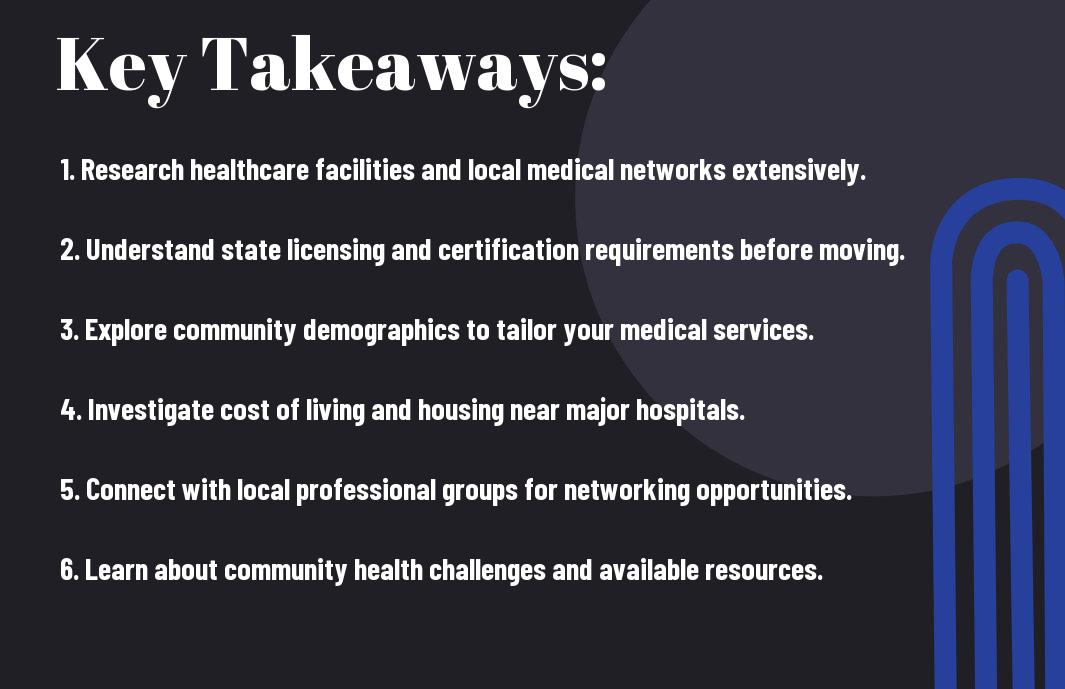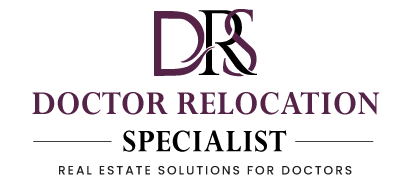Relocating as a medical professional comes with exciting opportunities and unique challenges. As you transition to a new community, it’s necessary to familiarize yourself with the local healthcare landscape, including hospitals, clinics, and available resources. Understanding the demographics and cultural nuances of your new environment will not only enhance your practice but also help you connect with your patients. In this post, we will explore key aspects you should consider to ensure a smooth integration into your new community.

Decoding Local Healthcare Systems
Understanding the mechanics of the local healthcare system is important for effective practice in your new community. Different regions can have diverse medical protocols, specialties, and patient demographics, impacting how you deliver care. Familiarizing yourself with local hospitals, clinics, and health departments will help you seamlessly integrate into your new role, ensuring that you are aware of referral networks and community resources available to your patients.
Assessing Quality of Care
Evaluating the quality of care provided by local healthcare facilities can significantly influence your professional decisions. Look into accreditation statuses, patient outcomes, and facility reviews to gauge how well these institutions serve their communities. Engaging with local providers and reviewing performance metrics can offer you insights into the reliability and effectiveness of care in your area, allowing you to make informed recommendations for your patients.
Navigating Insurance and Payment Options
Grasping the insurance landscape in your new community is vital for both you and your patients. Several types of insurance plans may dominate, and understanding basic coverage differences can enhance your practice. Familiarize yourself with local payers, such as Medicaid, Medicare, and private insurers, as well as the types of insurance accepted in each facility. This knowledge can help you provide patients with accurate information regarding their coverage, out-of-pocket costs, and available financial assistance options.
Insurance plans often vary not just in coverage but also in what they require for authorization, referrals, and payments. By examining the local insurance climate, you can ascertain which plans predominate and how they interact with various health services. For instance, some plans might offer more favorable terms for certain specialists or therapies, providing insight into resource allocation for your patients. Adjusting your clinical strategies to suit the local insurer preferences may also enhance patient satisfaction and compliance, while minimizing billing issues for your practice.

Finding Your Professional Network
Navigating a new medical community requires building a solid professional network. Connecting with local colleagues can provide invaluable insights on practice trends, referral patterns, and community health needs. As you integrate into your new environment, prioritize establishing relationships with other healthcare professionals and attending local conferences, all of which can expand your understanding of the regional patient population.
Establishing Connections with Local Colleagues
Engaging with local colleagues offers direct benefits, including mentorship opportunities and collaborative care practices. Attend meet-ups, workshops, or seminars where professionals in similar fields gather. Use social media platforms like LinkedIn to connect with colleagues, or reach out directly for coffee catch-ups to foster one-on-one relationships that could lead to future collaborations.
Joining Professional Organizations and Societies
Aligning yourself with professional organizations is an excellent way to integrate into your new community. Many fields have local chapters of national organizations that offer resources, continued education, and networking opportunities. Being an active member demonstrates your commitment to professional growth and can open doors for voice and influence within the community, allowing you to stay informed on industry standards and legislation affecting healthcare.
Joining professional organizations also provides access to exclusive resources, including industry publications, webinars, and job boards relevant to your new locale. Many organizations hold regular events, which can be an easy way to meet other professionals and share knowledge on the unique challenges and opportunities specific to your new environment. This approach not only enhances your skill set but also amplifies your visibility in the medical community, establishing you as a knowledgeable resource among peers.
Understanding Community Health Needs
Grasping the health needs of your new community lays the foundation for effective patient care and meaningful contributions. Engaging with local health initiatives, community leaders, and public health organizations will help you gain insights into prevalent health concerns and the resources available to address them. Your primary aim should be to assess both the strengths and challenges the community faces in terms of health services and access.
Analyzing Demographics and Health Trends
Examining the demographics of your new community reveals patterns that can highlight specific health trends. Factors like age, race, income level, and prevalent health conditions significantly impact the community’s health outcomes. For instance, if a high percentage of residents belong to minority groups, you may encounter unique health disparities requiring tailored interventions that consider cultural sensitivities and access barriers.
Identifying Gaps in Care and Opportunities for Impact
Recognizing the areas where healthcare services fall short enables you to make a substantial impact. Often, communities experience shortages in specialties, mental health services, or preventive care programs. Active participation in community forums or review of local health reports can reveal these gaps; knowing where the needs are allows you to tailor your approach to meet the community’s specific demands.
Assessing the community’s health landscape reveals potential avenues for improvement and innovation. For instance, if local hospitals are overwhelmed with pediatric cases but lack sufficient outpatient mental health resources, you might consider initiating a collaboration with school-based health programs. Establishing partnerships with organizations addressing social determinants of health can also enhance preventive care efforts that facilitate access to services. This proactive approach fosters trust within the community and fosters a healthcare environment prioritizing holistic well-being.
Thriving in a New Lifestyle
Embracing a new lifestyle while relocating as a medical professional can enhance both your personal and professional life. Adjusting to a new rhythm requires you to take an active role in your community, engaging with locals and participating in activities that interest you. This proactive approach not only enriches your social life but also enhances your understanding of the community’s dynamics, ultimately benefiting your practice and patient interactions.
Adapting to Cultural Nuances and Social Norms
Understanding the cultural fabric of your new environment is vital for fostering connections. Each community possesses unique traditions, communication styles, and social protocols. By observing local behaviors and participating in cultural events, you can navigate these nuances more effectively. Building rapport with patients and colleagues will often hinge on your ability to appreciate and adapt to these local customs.
Exploring Local Amenities and Resources
Your new community is filled with resources that can significantly enrich your quality of life. Start by mapping out vital amenities such as grocery stores, parks, gyms, and libraries. Discovering recreational activities, like local sports leagues or art classes, can open doors to new friendships. Additionally, familiarize yourself with healthcare resources, such as specialty clinics and fitness centers, to support your well-being during this transition.
Exploring local amenities goes beyond fulfilling daily needs; it’s about integrating into your new environment. For instance, finding a local farmers’ market can connect you with fresh produce while enabling you to meet community members. Joining a fitness club may introduce you to fellow professionals who share your interests, creating opportunities for networking. Look for volunteering opportunities with community health initiatives to build relationships while contributing positively to your new home. Engaging actively with these resources allows you to thrive both personally and professionally in your new setting.
Managing Relocation Logistics
Navigating the complexities of relocation logistics can feel overwhelming, but breaking it down into manageable tasks makes it easier. Start by creating a checklist that includes timelines, moving services, and important documents you’ll need to transfer your medical credentials. Research local regulations and licensing requirements specific to your new location to avoid surprises. Organizing every step will prevent potential mishaps that could delay your move and affect your career transition.
Housing Considerations for Medical Professionals
Finding the right housing is important for settling comfortably in your new community. Target neighborhoods that offer convenient access to your workplace, schools (if you have kids), and other amenities. Consider factors like safety, cost of living, and availability of rental properties or homes for purchase. Balance the proximity to your workplace with the lifestyle you envision; for instance, some prefer quiet suburban areas while others thrive in urban settings.
Balancing Work and Life During Transition
Maintaining a healthy work-life balance during your relocation requires proactive scheduling and self-care. Familiarize yourself with local social circles and recreational options to create a fulfilling, well-rounded life outside of work. Connect with coworkers to build a support network; they can provide recommendations on local services, events, and more. Allocate time for leisure activities and family bonding to ease the stress of the transition and help you integrate more deeply into your new community.
During this transition, you’ll want to prioritize both your professional responsibilities and personal well-being. Engaging in activities outside of work can help alleviate stress while building connections within your community. Attend local events or join clubs that align with your interests, which not only fosters social support but also creates opportunities for networking. Establishing boundaries between work and personal time will prove vital—set specific hours for work-related tasks and dedicate weekends or evenings for family and leisure, ensuring a balanced and fulfilling existence as you settle into your new locale.
Conclusion
To wrap up, relocating as a medical professional involves more than just transitioning your career; it’s about immersing yourself in a new community that will significantly impact your personal and professional life. You should take the time to research local healthcare needs, cultural aspects, and available resources that can enhance your experience. Networking with local professionals and participating in community events can help you build meaningful connections. By thoroughly understanding your new surroundings, you can better adapt and thrive in both your practice and personal life.

